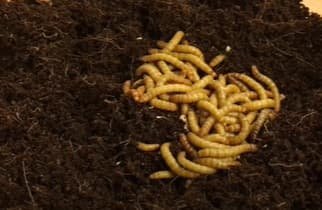
When it comes to studying or farming mealworms, it’s important to recognize that they’re more than just wriggly larvae. They’re the larval stage of the darkling beetle, and they can thrive in controlled environments. Think of them like mini powerhouses for turning waste into nutritious protein. So, can they be farmed or studied effectively in captivity? Let’s dive into that!
What Are Mealworms and Their Life Cycle?
Mealworms are the larvae of the darkling beetle, scientifically known as *Tenebrio molitor*. These little guys typically measure about 1.5 inches long when fully grown and have a smooth, segmented, and often shiny body. You might be wondering about their life cycle, which is pretty fascinating!
Mealworms start as eggs, which hatch into small larvae. After several molts, they transform into pupae, and eventually, they emerge as adult beetles. The whole process can take anywhere from three to six months, depending on conditions like temperature and humidity. This life cycle is important to understand if you’re considering keeping them. A stable environment can speed up growth and reproduction, making mealworm farming even more efficient.
Keeping them in captivity means replicating their natural habitat as closely as possible. That includes a temperature range of 70-80°F and a humidity level of around 60%. You can use simple containers like plastic bins, but make sure they have ventilation holes. Add some oats or wheat bran for them to munch on, which also serves as their bedding.
Benefits of Farming Mealworms
Farming mealworms has a lot of benefits. For starters, they’re incredibly efficient at converting feed into protein. What does that mean? It means you get more protein for less resource input compared to traditional livestock. In fact, mealworms require far less land, water, and food compared to cattle or pigs.
They also have a relatively short growth cycle, which means you can harvest them quickly. This is beneficial for both researchers and those looking to produce food. You might be surprised to know that mealworms can convert organic waste into high-quality protein, making them an environmentally friendly option for reducing waste while providing nutritious food.
Another win is their high nutritional value. Mealworms are packed with protein, healthy fats, and essential vitamins. Plus, they’re rich in fiber, which is great for gut health. If you’re into sustainable eating or have a farm-to-table mindset, farming mealworms is a smart choice that can lead to a healthier planet and a healthier you.
Can Mealworms Be Study Subjects?
Absolutely! Mealworms are fantastic subjects for various studies. They’re easy to care for, reproduce quickly, and are fairly resilient. This makes them ideal for educational purposes, such as in classrooms or research facilities.
You might find scientists using mealworms to study topics like environmental science, biology, and even genetics. Their adaptability and short life cycle allow for rapid experimentation, and researchers can easily manipulate their environment to see how different factors affect growth and behavior. For instance, you could study their response to temperature changes or different food sources.
Not only are they a great source for scientific inquiry, but they also offer insights into larger ecological questions. For example, scientists can explore how mealworms break down organic waste, contributing to discussions on sustainability and waste management.
Setting Up a Mealworm Farm
Setting up a mealworm farm isn’t as complicated as it sounds. If you’re ready to get started, here’s a simple breakdown of the steps involved:
- Choose Your Container: A plastic bin or a glass aquarium with proper ventilation works well.
- Add Bedding: Use oats, wheat bran, or other grains as bedding. This also serves as their food.
- Control the Environment: Keep the temperature around 70-80°F and humidity around 60% to optimize growth.
- Introduce Mealworms: Start with a small batch of larvae. You can purchase them online or from pet stores.
- Feeding: Provide a consistent food supply and change bedding every few weeks to keep things clean.
By following these steps, you can create a thriving mealworm farm in no time! It’s like starting your own mini ecosystem, and you’ll be surprised at how quickly they grow.
Common Challenges in Mealworm Farming
While farming mealworms can be fun and rewarding, there are a few challenges you might face. The first one is maintaining the right conditions. If it gets too hot or too cold, it can slow down their growth or even kill them off. You might find yourself checking the temperature more often than you’d like!
Another issue is mold. Since they eat organic materials, things can get a bit damp. If you notice any white or fuzzy growth in their bedding, it’s time to clean house. Regularly refreshing their bedding and ensuring proper ventilation are key to preventing mold.
Pests are another concern. Keeping your mealworm farm clean can help deter unwanted guests like mites or flies. A little bit of maintenance goes a long way in keeping your mealworms healthy and happy!
In conclusion, mealworms offer a unique opportunity for both farming and scientific study. They’re not just an easy protein source; they can also be a valuable tool for understanding ecological concepts and food sustainability. Whether you’re considering mealworms as a small-scale farming project or looking into their research potential, there’s a lot to learn and explore.
So, if you’re feeling adventurous or just curious, setting up a mealworm farm might be just the thing for you. It’s a small step towards sustainable living, and who knows? You might just become a mealworm enthusiast!
